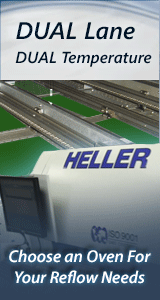Printed Circuit Board Assembly & PCB Design Forum
SMT electronics assembly manufacturing forum.
- SMTnet
- »
- Electronics Forum
- »
- Vapor Phase Oven
Vapor Phase Oven
Views: 3149
![]() Hi, We have a client requiring us to use a Vapor Phase Reflo...
- Aug 08, 2012
by
Jorge_Quijano
Hi, We have a client requiring us to use a Vapor Phase Reflo...
- Aug 08, 2012
by
Jorge_Quijano
![]()
![]()
![]() Vapor soldering has some advantages for heavy boards, especi...
- Aug 08, 2012
by
Hegemon
Vapor soldering has some advantages for heavy boards, especi...
- Aug 08, 2012
by
Hegemon
![]()
![]() The unique heat on the PCB is the big advantage and you also...
- Aug 10, 2012
by
Th. Meier
The unique heat on the PCB is the big advantage and you also...
- Aug 10, 2012
by
Th. Meier
![]()
- SMTnet
- »
- Electronics Forum
- »
- Vapor Phase Oven







